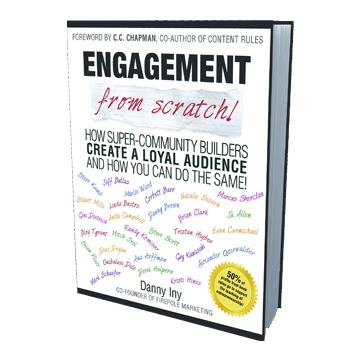How To Find And Validate Membership Site Ideas: The Proven Guide
Qhubekani T. Nyathi
It all sounded easy.
Scaling your business through a membership site would be a breeze. You could almost touch, feel, and smell the bright future ahead.
You pictured yourself sipping Pina Coladas while your virtual cash register rang nonstop as people joined your paid community in droves.
You saw a life free from the claws of debt. Freedom to spend quality time with family and loved ones was within touching distance.
And then… bam!
A flood of tricky questions engulfed you:
How do I find and validate membership site ideas?
What if I pick the wrong one from the myriad options?
Suppose my idea bombs after a big expensive launch?
What if it takes forever to discover a viable idea?
Do I have the expertise to produce quality content over the long haul?
Your initial ecstasy turned into agony. Too many *what ifs* to contend with. And you felt the dream slipping away before you reached the starting blocks.
Now you’re stuck, swamped, and stumped.
You’re not sure if you can pull it off anymore. It’s more daunting than you thought.
Thankfully, there’s a way out of this maze. You don’t have to spin your wheels anymore.
In this post, I’ll show you tried-and-tested ways of finding and proving lucrative membership website ideas.
How to Come Up with Profitable Membership Site Ideas
First, here’s what you shouldn’t do:
Don’t go into your creativity secret room and dream up fancy ideas you think your audience will like.

It’s a trap most entrepreneurs fall into—putting themselves ahead of the audience. This can only lead to failure and frustration when your ‘flawless’ idea is rejected.
Step 1: Start With Your Audience Needs
Instead, use an audience-first approach.
Focus on their needs, frustrations, and dreams—not yours. After all, business is all about serving your audience while generating income and making an impact.
Put them first, they’ll lead you to profit-making ideas. Pay close attention to your audience. They’re already telling you what they want.
But how do you do it?
There are 4 ways of coming up with feasible ideas. The first two work if you already have an audience.
1. Popular Content
Well-liked content that resonates with your audience is a big indicator of which ideas they love and will gladly pay for. Popular posts are a giveaway of their preferences.
- Check your popular posts to get a general feel for the things your audience enjoys.
- More than what you said in the post, identify what you didn’t say. It’s by filling that content gap that you can cash in.
- To identify these gaps, scour through the comments section. Identify issues people wish you would have covered but didn’t.
- Then, list the potential ideas.
2. Frequently Asked Questions (FAQs)
When your audience asks questions, get your antennas up. They’re sharing their pain points and crying out for answers. FAQs are a treasure trove for solid membership ideas.
- Go through your inbox and popular posts.
- Identify questions asked by your audience.
- Make a comprehensive list of all these questions.
- And then make a shorter list, using any often-repeated questions.
But, what if you don’t have an audience?
Don’t worry, I’ve got you covered. The next two tactics will work for you.
3. Question and Answer Sites
Q&A websites like Quora and Yahoo Answers are great for testing your idea, even if you don’t have a following.
Here’s how:
- Formulate a question related to your idea.
- Type your question into the search box and hit search.
- If it comes up in the search, you’re onto something! If not, sorry, maybe your idea’s not likely to be a hit.
- Check how much engagement the question provokes: the higher the engagement, the higher your chances of success (and vice-versa).
4. Secret Competitor Files
To get an idea of what’s working, “spy” on your competition (with your audience’s help). And I’m not talking about regular competitor analysis.
Choose a popular service or product related to your idea. Scour the reviews. Identify what folks are unhappy about. What do they wish was included?
You don’t need to produce something original. There’s no market for it. And convincing people to join such a site would be tough.
Latch onto an idea with a ready market and add your twist to it. But don’t be entranced by the competition. Only seize what they’re missing.
Once you’ve looked at your audience, circle back—and look at yourself.
Step 2: Determine Your Expertise
Having a list of stellar ideas is great. But it’s not enough.
To serve your audience well and make the biggest impact, link those ideas to your expertise.
Don’t let the word ‘expert’ scare you. We’re not talking about academic degrees. If your knowledge is a rung or two higher than of your audience’s, you are an expert. They can learn something from you. So chill, you’ve got this. 🙂
Find the balance between a rock-solid idea and your best skills:
Lucrative idea + Low expertise = Frustration for your audience and high dropout rates.
Unprofitable idea + High expertise = Frustration for you as you won’t be able to sustain the site.
Lucrative idea + High expertise = Joy (plus money) for you and joy (plus transformation or results) for your audience.
The third scenario is where you should aim.
How do you find an idea that dovetails with your expertise and gifts? Do a personal inventory of your skills. Make a list of your answers to each of the following 4 categories.
Professional Qualifications
Start by listing your professional skills.
Qualifications build your credibility. They are particularly useful in certain industries like health.
Don’t have paper qualifications that match your idea? It’s nothing to fuss about. There’s something more important you have at a practical level that qualifies you to teach your target audience.
And that is…
Personal Accomplishments
Over the course of your life, you’ve done amazing things.
It doesn’t matter if you achieved these uncommon results in your professional or personal capacity. What’s crucial is for these experiences to tie in with what your audience wants to learn from you.
- Maybe you are a veteran with extensive experience in your field. Your audience can learn from you.
- Perhaps you achieved results faster than usual. You can teach people about your process.
- Maybe you went through a deep transformative experience. Leverage it to teach, support, and inspire your audience members.
- Perhaps you discovered a new way of doing something… teach that.
- Or maybe you won some kind of personal or professional awards.
Passion Pointers
By passion, I’m not talking about the goofy feel-good version pushed by panderers bent on selling you an empty dream.
I mean a steadfast deep-seated drive to make the world a better place.
- What can’t you stop doing as a service to mankind? Something you feel you must do, a non-negotiable contribution.
- What would allow you to happily serve your niche, even if you weren’t paid a penny for it for the rest of your life?
- If money or resources were not a factor, what would you do or build?
- What causes do you volunteer for or give to?
- What irks you about your niche or the world? (What angers you is a clue to what you’ve been called to correct.)
Personal Inner Circle
It’s undeniable. Those closest to you know you best. They know your strengths, and ahem, weaknesses, better than anyone out there. Draw from their intimate knowledge.
These people include:
- Family members.
- Friends (current and childhood)
- Teachers and mentors
- Online community members
- Mastermind group members
Once again, don’t complicate things. A simple direct question like this one will do:
What’s my biggest strength? Or What am I superb at?
Ask 5-7 people and record their responses.
Finally, put all 4 lists side by side: your professional qualifications, accomplishments, passion, and your inner-circle-approved abilities.
“How do you determine your expertise? It's a mix of your professional qualifications, accomplishments, passion, and abilities.”
Tweet Me
Look for overlaps. There, in the convergence zone, is your expertise.
That wasn’t difficult, was it?
Now that you know your expertise and gifts, you’ll forge ahead with greater confidence.
How to Validate Subscription Website Ideas
Next, verify if your ideas are accurate and profitable.

How? Easy.
Go On a Social Media Espionage Mission (Say What?!)
Don’t worry. You don’t have to do anything illegal 🙂
Becoming an online spy means secretly listening in on the conversations your audience is having in their favourite online watering holes.
On social media, people tend to be:
Relaxed. Unguarded. Passionate.
They say a lot. You can glean precious nuggets from their conversations and contributions if you are a good listener. You’ll hear their struggles, pleas, and longings.
Where do you listen?
- Social media channels like LinkedIn, Facebook, and Twitter.
- Niche communities where people interact with like-minded folks.
- The comments section of popular niche sites, as they engage with touching posts.
- Review sites for no-holds-barred feedback about a service/product.
- Discussion websites like Quora and Reddit where people discuss various topics.
What do you look for?
Probe their P. A. I. N. S.
- Protestations
- Aspirations
- Inquiries
- Novelties
- Struggles
Let’s unpack this.
Protestations
People don’t complain because they want to cause trouble (except one or two maybe *wink*). They complain because they care deeply about something. They want vexing problems solved. A complaint is a plea for help.
- “I’m frustrated. My days seem to fly by. The day is over before I know it and I get ticked off when I realize I didn’t achieve much.”
Aspirations
Humans long for something better. It’s how we are wired. If you dial in on those wishes and desires, you can impact your audience in powerful ways.
- “As a freelance writer, I often feel lonely. How I wish there was somebody walking alongside me to offer support, guidance, or just be there as a sounding board.”
Inquiries
Questions, whether they’re from the teacher or the students, are the mother of learning. They’re so revealing. One good question can open up a world of possibilities and lead you to rich themes you can use for your site.
- “Why isn’t there an online group for first-time moms? I think it’d be fun to learn and share with people who get you. Other folks are clueless about what we go through and the kind of support we need.”
Novelties
Deep down we know there must be something higher, superior, finer reserved for us out there. To reach it, we must move from the old to the new.
- “Why are we stuck with [service] despite its well-documented shortcomings? We deserve better!”
Struggles
Business is all about solving people’s struggles or problems in a financially sustainable way.
- “Trying to lose weight has been a struggle for me. I start off with verve for two weeks and lose 1 or 2 kilos. Then I lapse back into my old unhealthy habits, lose motivation, and gain back all the weight. Ugh.”
The key is to look for patterns and come up with a bunch of core topics related to your subject.
“How can you figure out a great membership site idea? Identify your audience’s protestations, aspirations, inquiries, novelties, and struggles.”
Tweet Me
Unlike a course where you must be hyper-specific, with membership sites you can be broad and incorporate several key topics you can build your site around.
Sift Through Amazon Reviews
Amazon, the e-commerce colossus and third largest search engine in the world, can be a huge help when validating subscription website ideas with commercial potential.
The reviews section can help you get a feel for the right idea.
Here’s a simple 3-step process of how to go about it.
- Search for a topic idea using related keywords.
- Read reviews of the top sellers.
- Focus on concerns raised by 1- to 3-star reviewers.
Be on the lookout for these trigger phrases that show people are not only interested in the topic but will pay for it as well:
- “I wouldn’t mind paying for X if it can help me deal with Y”
- “Investing in such a service would be worth it.”
- “I’m willing to give anything to make this happen.”
- “I’d buy without a second thought.”
- “I’d do whatever it takes to be part of such a group.”
- “If they fix A, B, C then I’ll definitely recommend it with no misgivings.”
These ‘purchase intent’ phrases show your audience is committed to transformation. They’re not just excited. All they’re waiting for is a trusted guide (that’s you my friend) to take them to the promised land.
Bonus Point: The material you gather when doing social media research is gold dust for your landing pages. Sprinkle this user-generated content (info posted by your audience on online platforms) on your landing page so it sparkles and converts more.
It will convert because your readers see themselves in the copy. They might even think you’re psychic. 😉
Now that you know your passion and have several ideas on hand, it’s time to weigh them and nail the best idea.
How to Pick ONE Membership Site Idea From a List of Many
Phew.
You’ve done a lot of hard work so far. You’ve come up with several ideas you feel your audience would pay for. But it’s not over yet. It’s time to pick the winning concept.

To zero in on the best membership site ideas…
Survey Your Audience
Want to know what your audience thinks about your membership ideas?
Ask them.
If you hear it straight from the prospects’ mouths, you’ll be sure you are on the right track.
Use a one question survey:
“What’s your biggest struggle with [topic]?”
Or…
“What do you need help with most with [topic]?”
That’s it.
Because the question is brief, you’ll be tempted to embellish it. Don’t succumb to the urge.
The open-ended nature of these questions is beneficial. They allow people to speak from their hearts. They’re for brainstorming potential ideas at the beginning and for confirmation at the end of the validation process.
Sift through the answers and go with the top answers that match your earlier list. Those are your winners.
Or, you can do the multiple-choice questions survey. Use the material you’ve gathered so far to come up with the questions.
A popular survey method to try is the Ask Method.
However, surveys only work if you have a large audience—at least 1000 true fans. Why? The results may deceive you. Say you ask a list of 100 people about your idea. Half of them say it’s awesome. That’s wonderful, right?
Wrong.
50 is not a significant number in the big scheme of things.
Run a Beta Group
While private research can yield interesting insights, nothing beats trying out your idea in the real world with real people.
Rope in a dozen ideal people who fit your customer profile. Gauge interest in your idea by running a beta group. Don’t worry about producing a site with all the frills at this point. Choose the cheapest and easiest option available.
You can run your membership area on Facebook, Slack, or use a WordPress Membership Plugin.
Chat With People on the Phone
Talking with people on the phone adds a new dimension to your research.
- You pick up emotions and nuances.
- You get the chance to probe further.
- Your audience can ask questions.
The rich info you dig up on these chats is invaluable not just for your membership site but for other aspects of your business as well. By talking directly to your potential customers, you discover and refine the very best membership site ideas.
Ultimately, validation boils down to 3 simple things:
- Talk to your audience and generate a few ideas.
- Try out one or two of those membership ideas.
- Tweak your offering based on audience feedback.
Does all this advice work in the real world? Well, let’s find out…
Subscription Website Ideas: A Real Life Case Study Featuring Jacob McMillen
I reached out to Jacob McMillen, a multiple six-figure copywriter and content strategist. He’s fresh from launching Write Minds, a membership site for freelance writers.
I asked him to share his validation process from concept to launch, and boy did he deliver! He’s how he did it.

“The journey that led me to create Write Minds started with a simple goal. I had managed to hit a consistent six figures as a freelance writer, and I wanted to identify a reproducible way to help other freelance writers do the same.
From what I could see, there were a lot of courses and communities already built around this goal, but the problem was that they were all focused solely on information, and for a lot of writers, that didn’t seem to be enough.
I didn’t know if I’d find a scalable or even profitable way to solve this problem, but I was determined to find a legitimate solution and then worry about the other stuff later.
Over the next two years, I tried a number of strategies. I tried 1-to-1 mentorship, group mentorship, and a generic membership group. I even built a small agency to see if onboarding and employing writers would succeed where the other strategies failed.
Each of these solutions failed to achieve the core goal, but at the same time, each one exposed tangible problems that needed to be addressed in whatever solution I ultimately created.
I made some key discoveries:
- Not everyone was cut out to succeed at freelancing, so I needed a way to filter between people who could be helped and people who would just be wasting their own time.
- People who were more similar to myself tended to benefit the most from my training and mentorship, so I needed a way to better help people who were very different from me but still had what it took to succeed as a freelancer.
- Systematic training was most helpful for people between $0-$2k/month income. Past $4k/month, training had little to do with success. It mostly came down to consistency and focusing time and effort on the right targets.
- I also observed that emotional connection was a huge need for many freelancers, and the moment a freelancer hit their income goals, that became the most pressing need on their minds.
I didn’t know any of this when I first started trying to solve this problem. I just knew the current info-only model wasn’t working, and with each strategy I tried, I learned why those wouldn’t work either.
With all the feedback I collected from trial and error, I was able to make a product plan that included an info-based course for writers focused on reaching their first $2k per month while developing their core service and understanding of freelancing, and then a membership group primarily for writers who had already crossed that income threshold and are now dealing with scaling, long term consistency, and emotional connection.
I was able to create a lot of really strategic parameters for the group thanks to the lessons learned in previous attempts, and so far, the group has been a great success, although I won’t call it a definitive success until we’ve made it through our first 12 months with members ecstatic to stay in the group.”
Jacob’s approach was driven by a fierce desire to serve his audience.
Here are the highlights I picked from his story:
Key Takeaways
- Start (validating your idea) even if you haven’t figured out everything yet.
- There’s no substitute for going out there and trying things out with your audience in a small setting.
- Identify a gap in the market you want your site to fill—that gap becomes your Unique Selling Proposition (USP).
- Keep iterating your idea using feedback from your audience until you hit the jackpot.
I’m sure you’ll agree with me when I say: launching a membership site from scratch is doable.
Take Your Membership Website Idea From a Dream to Reality
Coming up with profitable membership site ideas sounds overwhelming at first. In most cases, it’s because you don’t have a well-thought-out line of attack.
But with a proven method it’s straightforward.
What’s the secret?
Put your audience at the dead centre of the process.
Talk to them. Listen to them. Test out ideas with them. Eventually, a viable and lucrative idea will emerge and you’ll soon be on your way to achieving your recurring income dream.
Pina colada anyone?
And if you’re in search of additional information about how to turn your members into a super-engaged community, be sure to pick up your free copy of Engagement from Scratch!
Create Your Loyal Audience (from Scratch!)
Get the guidance and insights from 30 of the world’s most successful audience- and community-builders to turn your internet business into a true audience business.

Amar Kumar
Hello Qhubekani,
The first step in validating your membership idea is to research the competition. When developing a business idea, it’s important to know who your perfect customer or member persona is.
It’s what defines your target audience and helps you create content and a product aimed specifically at them. Validating your membership-site idea gives you a level of certainty that your project will be a success.
Nothing is guaranteed, and you may still get it wrong, but the more time you spend validating your idea and finding out if there’s a real demand for what you’re proposing, the more your chance of success.
Eventually, thanks for sharing these amazing facts regarding wonderful topic.
With best wishes,
Amar Kumar
Qhubekani Nyathi
Hi Amar,
Thanks for weighing in.
Yes, researching the competition is part of the process. I deliberately touched on it in passing because many people become obsessed with the competition instead of focusing on what they can do better than the competition. Of course, to nail that you have to investigate your challengers. But it’s important not to get hung up on what they are doing.
Thanks also for bringing up the excellent point about knowing who your perfect customer is. It’s a crucial element of the testing phase.
So happy you stopped by Amar!
See you around 🙂